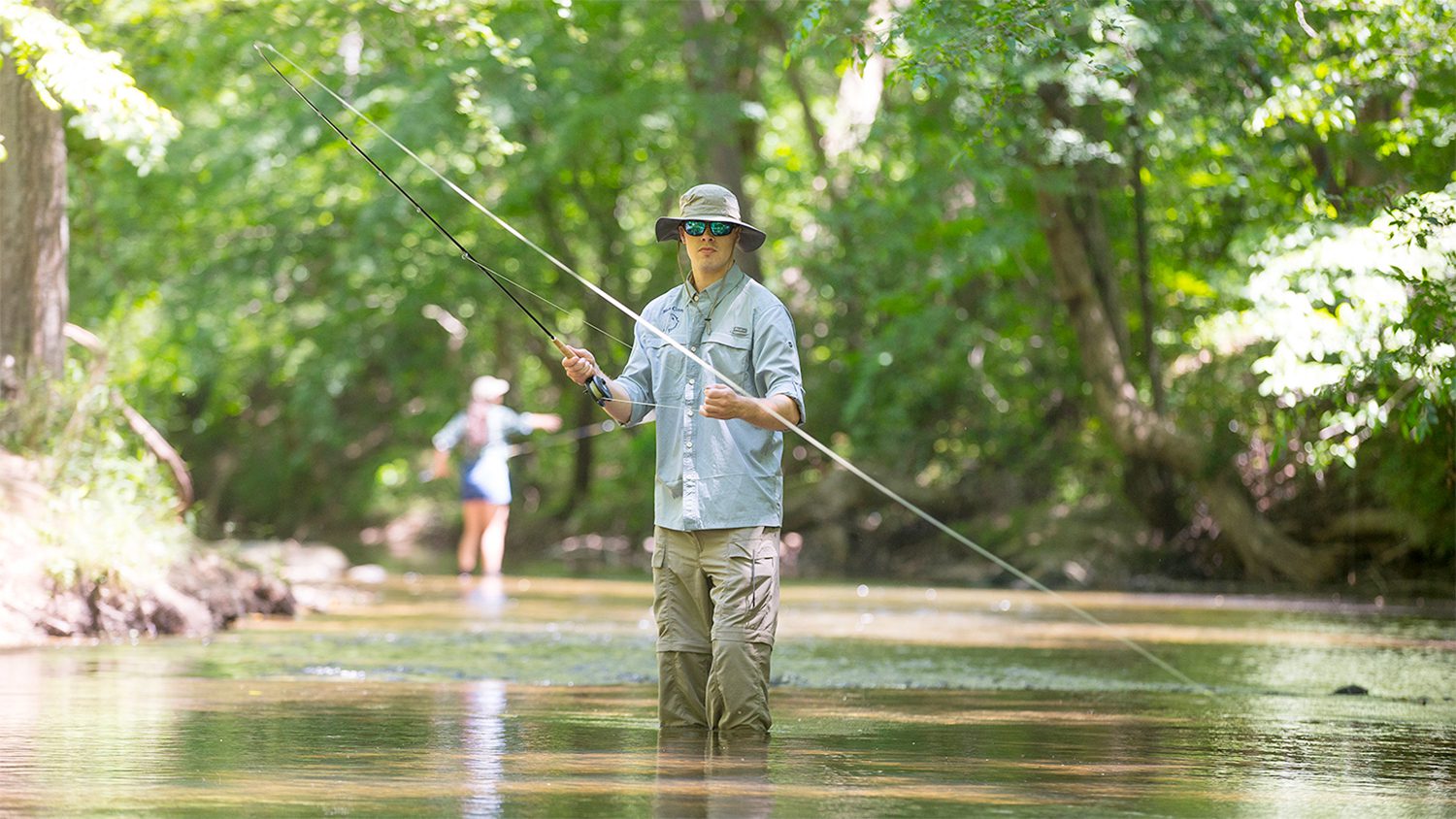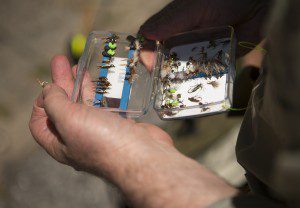Gone fishing

Amy Poon ’16 brought her new graphite fly rod to Furman Lake for the first time Wednesday. It was her first time fishing at the lake, or anywhere for that matter.
She’s feeling a bit nervous, but she lines herself up and makes sure everything is ready for her to cast the line. She’s ready. She flicks her wrist and the rod bends, and stops. It bends again and stops. The nymph snags on a branch in the water, but she’s able to wriggle the fly loose and try again.
Her first afternoon of fly fishing is challenging, but Poon’s determination quickly pays off. She and her classmates are fishing on the Saluda River the next day when she gets an unexpected surprise: an 8-inch-long brown trout at the end of her line.
“Feeling that unexpected, sharp pull on the fly line was exhilarating,” said Poon, an Asian studies major.
Poon is one of a dozen students from diverse majors who spent three weeks taking Fly Fishing and River Conservation, a May Experience course taught by Douglas Koppang ’76 and Associate Director of the Center for Teaching and Learning Mike Winiski ’89, and assisted by Anna Riethman ’15.
The idea came about after Koppang, an avid fly fisherman, read an article in Furman magazine about May Experience courses. He had recently read about the death of George Harvey at age 93, a renowned fly fishing pioneer who taught the first college accredited fly fishing course at Penn State for four decades.
“If they could teach fly fishing at Penn State, why not at Furman?” thought Koppang, who called then-Alumni Director Tom Triplett to ask about the possibility of offering a new fly fishing May X course. Fly fishing, with its emphasis on “catch and release” ethics fits well into the EES curriculum, which focuses on sustainability of natural resources, Koppang said.
The first Fly Fishing and Rivers May X course in 2014 was sponsored by Professor Emeritus Frank Powell and Koppang, one of Powell’s former students. Offered once again this year, the course has remained a successful collaboration between Furman faculty, staff, and alumni.
Two-thirds of the class is taught outdoors along riverbanks, on lakefronts and in streams, where students learn how to “read” the water to locate fish and can practice their fly casting and tying skills.
In addition to the history of fly fishing, watershed geology, stream structure, and river conservation are discussed. Students learn about trout biology and behavior, aquatic insects and other species. They also consider their roles in nature and how humans interact with their environment.
Trips to fishing spots, including the Saluda, Davidson, and Chattooga rivers, Jones Gap State Park and Pisgah National Forest are all part of the experience for the philosophy, religion, history, business, and Asian studies majors, many of whom are fly fishing for the first time.
Students learn about the gestalt of fly fishing and supplement their outdoor experience with selected fly fishing literature from authors such as Ernest Hemingway, and Norman Maclean, who wrote the classic novel, A River Runs Through It.
Koppang, a life-long fisherman, and an avid fly fisherman for the past 20 years, first picked up an Orvis catalog and taught himself the basics. He now takes vacation time from his job as Senior Vice President of Business Development at Cardiovascular Care Group in Nashville, Tenn., to share with Furman students what he has learned.
“Fly fishing is a great way to engage the natural world in a responsible manner, and to gain an appreciation for the fragile nature of these mountain stream ecosystems,” Koppang said.
Students learned about the stream conservation efforts of Trout Unlimited, an organization dedicated to preserving and restoring healthy stream habitat for trout. “Trout need very clean water to survive,” said Koppang. “In order to maintain a healthy environment for humans we must preserve the natural habitat of trout that live in these clean mountain streams.”
Koppang said he wants to demonstrate to students that fly fishing is not as complicated, or difficult as some people think. By teaching them the basics in order to enjoy fly fishing, he hopes to encourage a younger generation to become engaged in a sport that involves a lifetime of learning, and to continue to serve as good stewards of the environment.
Matt Consolo ’18, had considered taking a computer science course, but after his friend, J.P. Burleigh ’18, told him about the chance to learn fly fishing at Furman, Consolo said he changed his mind.
At first, he felt a bit intimidated since it was an all-day course and he had limited experience with fishing. Soon, with the readings and outdoor instruction, he felt at ease.
“It’s not about catching fish. It’s about loving the sport,” Consolo said. “You can’t beat being outside all day.”
After taking the course last year as a rising senior, Riethman enjoyed it so much she stayed at Furman after graduation to help with the course as a Teaching Assistant.
“Initially, I wasn’t hooked on it,” said Riethman, who describes fly fishing as her lifelong hobby. “Now, I really enjoy being out on the river. It’s such a peaceful experience.”
One of the highlights of the class for Poon was their trip to Pisgah National Forest, where she caught her first rainbow trout.
“It was gorgeous. It’s one thing to see a rainbow trout in pictures, but to see it in person and in the water is incredible,” said Poon. “I now know why fly fishermen (and women) describe this sport as addictive.”
“There aren’t a lot of opportunities to spend three weeks of your life learning how to fish,” she said. “I already know that I’ll be asking for a fly rod for Christmas.”
Poon, a resident of Tampa, Fla., said she looks forward to sharing her love of fly fishing with family and friends. “Taking this class has introduced me to a new sport that has no age limit,” she said.
Learn more about May Experience at Furman.
